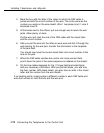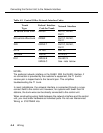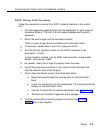
Connecting the Control Unit to the Network Interface
CAUTION:
Wiring
■ The telephone company is responsible for providing
appropriate protection for central office trunks. Do not
connect the central office trunks until you are certain that they
are properly protected. See the section, “Central Office Trunk
Protection,” in Chapter 2 for details.
■ To avoid coupling power supply noise onto system wiring,
allow at least 3 inches (8 cm) of clearance between the basic
carrier’s power supply and any wiring or termination hardware
located left of the control unit.
■ If the network interface is greater than 25 ft (7.6 m) from the
control unit, connect the control unit to the network interface
using an off-premises range extender (OPRE)
See the documentation packaged with the OPRE for complete
installation instructions
■ If staples are used to attach the cords to walls or baseboards,
check that the cords have not been pierced.
■ National and local building codes specify the type of cable
required for telecommunication wiring. For example, indoor
wiring (DIW) cable cannot be used inside or on top of air
plenums or ducts, along hot pipes, or across walkways.
Consult your local ordinances and regulations for proper
cable selection.
The local telephone company should have already installed the network
interface (the central office trunks). Before you install the system, verify that
the network interface is the proper type and that it is located within 25 ft
(7.6 m) of the control unit. If the network interface is more than 25 ft (7.6 m)
from the control unit, make sure you have an OPRE; see the caution above.
4-2
Wiring


















